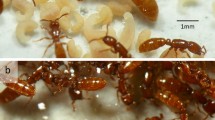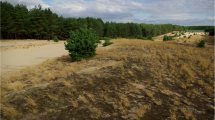Abstract
We studied 12 species of Strumigenys and confirmed the existence of class-1 apicofemoral and apicotibial glands as exclusive exocrine structures in workers, queens and males in this ant genus. Contrary to the majority of Strumigenys species, these glands are lacking in workers of S. mutica although they are present in queens. This striking discovery may be related with the social parasitic lifestyle of this species; however, it remains entirely speculative in which way the absence of these glands in workers could be beneficial for their social parasitism. The ultrastructure of the glands displays unique epithelial characteristics which include their bowl shape, the occurrence of a swollen nerve wedged between the gland cells and a complex system of irregular microvilli that are separated from the overlaying cuticle by a cytoplasmic layer. Although the function of the glands is still unknown, their cytoplasmic appearance indicates the production of a possibly pheromonal secretion. In addition to the epithelial apicofemoral and apicotibial glands, we also found class-3 dorsodistal femoral and dorsodistal tibial glands as new structures in the exocrine repertoire of ants. As these glands are also present in S. mutica queens but absent in workers, it is a challenge to further study and understand the social parasitism of this species.





Similar content being viewed by others
Data availability
All histological sections used in this study are available in the Zoological Institute of KU Leuven, Leuven, Belgium.
References
Beani L, Calloni C (1991) Leg tegumental glands and male rubbing behavior at leks in Polistes dominulus (Hymenoptera: Vespidae). J Chem Ecol 4:449–462. https://doi.org/10.1007/BF01049330
Billen J (1997) Morphology and ultrastructure of the metatibial gland in the army ant Dorylus molestus (Hymenoptera, Formicidae). Belg J Zool 127:179–186
Billen J (2009) Occurrence and structural organization of the exocrine glands in the legs of ants. Arthropod Struct Dev 38:2–15. https://doi.org/10.1016/j.asd.2008.08.002
Billen J (2019) Capítulo 7 Diversidad y morfología de las glándulas exocrinas en las hormigas. In: Fernández F, Guerrero RJ, Delsinne T (eds) Hormigas de Colombia. Universidad Nacional de Colombia Press, pp 165–174
Billen J, Ito F, Bolton B (2000) Femoral and tibial glands in the ant genus Strumigenys (Hymenoptera, Formicidae). Belg J Zool 130:111–115
Billen J, Bauweleers E, Hashim R, Ito F (2013) Survey of the exocrine system in Protanilla wallacei (Hymenoptera, Formicidae). Arthropod Struct Dev 42:173–183. https://doi.org/10.1016/j.asd.2013.01.001
Billen J, Lin C-C, Esteves FA (2020) Novel exocrine glands in the foreleg coxae of Discothyrea ants. Arthropod Struct Dev 59:100981. https://doi.org/10.1016/j.asd.2020.100981
Billen J, Khalife A, Ito F, Duc Anh N, Esteves FA (2021) The basitarsal sulcus gland, a novel exocrine structure in ants. Arthropod Struct Dev 61:101041. https://doi.org/10.1016/j.asd.2021.101041
Blomquist GJ, Bagnères A-G (2010) Insect hydrocarbons: biology biochemistry and chemical ecology. Cambridge University Press, Cambridge. https://doi.org/10.1017/CBO9780511711909
Bolton B (1999) Ant genera of the tribe Dacetonini (Hymenoptera: Formicidae). J Nat Hist 33:1639–1689. https://doi.org/10.1080/002229399299798
Bolton B (2000) The ant tribe Dacetini. Mem Amer Entomol Inst 65:1–1028
Brown WL Jr (1955) The first social parasite in the ant tribe Dacetini. Insect Soc 2:181–186
Chaul JCM (2018) Estudos morfológicos e taxonômicos do gênero Strumigenys Smith (Hymenoptera: Formicidae: Myrmicinae). MSc thesis Universidade Federal de Viçosa, MG, Brazil, pp 102
Cruz Landim C, de Moraes RLMS, Salles HC, Reginato RD (1998) Note on glands present in Meliponinae (Hymenoptera, Apidae) bees legs. Revta bras Zool 15:159–165. https://doi.org/10.1590/S0101-81751998000100014
D’Ettorre P, Errard C, Ibarra F, Francke W, Hefetz A (2000) Sneak in or repel your enemy: Dufour’s gland repellent as a strategy for successful usurpation in the slave-maker Polyergus rufescens. Chemoecology 10:135–142. https://doi.org/10.1007/PL00001815
Gobin B, Ito F, Billen J (2003) The subepithelial gland in ants: a novel exocrine gland closely associated with the cuticle surface. Acta Zool (Stockholm) 84:285–291. https://doi.org/10.1046/j.1463-6395.2003.00149.x
Guillem RM, Drijfhout F, Martin SJ (2014) Chemical deception among ant social parasites. Curr Zool 60:62–75. https://doi.org/10.1093/CZOOLO/60.1.62
Hölldobler B, Obermayer M, Peeters C (1996) Comparative study of the metatibial gland in ants (Hymenoptera, Formicidae). Zoomorphology 116:157–167. https://doi.org/10.1007/BF02527156
Lenoir A, D’Ettorre P, Errard C, Hefetz A (2001) Chemical ecology and social parasitism in ants. Annu Rev Entomol 46:573–599. https://doi.org/10.1146/annurev.ento.46.1.573
Mori A, Grasso DA, Visicchio R, Le Moli F (2000) Colony founding in Polyergus rufescens: the role of the Dufour’s gland. Insect Soc 47:07–10
Nijs C, Billen J (2015) Exocrine glands in the legs of the social wasp Vespula vulgaris. Arthropod Struct Dev 44:433–443. https://doi.org/10.1016/j.asd.2015.08.011
Noirot C, Quennedey A (1974) Fine structure of insect epidermal glands. Annu Rev Entomol 19:61–80. https://doi.org/10.1146/annurev.en.19.010174.000425
Taylor RW (1968) The Australian workerless inquiline ant, Strumigenys xenos Brown (Hymenoptera-Formicidae) recorded from New Zealand. N Z Entomol 4(1):47–49. https://doi.org/10.1080/00779962.1968.9722888
Wang C, Lin C-C, Billen J (2021) Morphology of the novel ventral scape gland in the ant genus Strumigenys. Arthropod Struct Dev 63:101063. https://doi.org/10.1016/j.asd.2021.101063
Wang C, Lin C-C, Keller RA, Billen J (2021) The ‘hairwheels’ in Strumigenys ants are not glandular. Asian Myrmecol 13:e013004. https://doi.org/10.20362/am.013004
Wang C, Steenhuyse-Vandevelde M, Lin C-C, Billen J (2021) Morphology of the novel basimandibular gland in the ant genus Strumigenys (Hymenoptera, Formicidae). Insects 12:50. https://doi.org/10.3390/insects12010050
Wilson EO, Brown WL Jr (1956) New parasitic ants of the genus Kyidris, with notes on ecology and behavior. Insectes Soc 3:439–454
Acknowledgements
We thank An Vandoren for making the sections for electron microscopy. We also thank the Taiwan Agricultural Research Institute Council of Agriculture, Executive Yuan for using the scanning microscope. We acknowledge the valuable comments and recommendations by Júlio Chaul and two anonymous reviewers that helped to improve the manuscript. This project was funded by the China Scholarship Council, grant number 201906300043, and a research grant from the Ministry of Science and Technology, Taiwan (MOST 109-2621-B-018-001).
Author information
Authors and Affiliations
Corresponding author
Rights and permissions
Springer Nature or its licensor (e.g. a society or other partner) holds exclusive rights to this article under a publishing agreement with the author(s) or other rightsholder(s); author self-archiving of the accepted manuscript version of this article is solely governed by the terms of such publishing agreement and applicable law.
About this article
Cite this article
Wang, C., Chung, FY., Lin, CC. et al. Differences in the occurrence of leg glands between the social parasite S. mutica (Brown, 1949) and other Strumigenys ants. Insect. Soc. 70, 233–242 (2023). https://doi.org/10.1007/s00040-023-00912-9
Received:
Revised:
Accepted:
Published:
Issue Date:
DOI: https://doi.org/10.1007/s00040-023-00912-9




